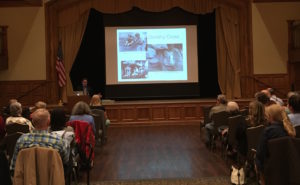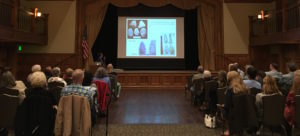Dr. Lattanzi, Curator for the Bureau of Archaeology and Ethnology at the New Jersey State Museum in Trenton, was the featured speaker before dozens of people at the October 13 Annual Meeting of the Historical Society of Moorestown held at the Community House. He provided a fascinating overview of the way of life of native peoples and the geological and climatological conditions of pre-historic New Jersey.
Archaeological studies in New Jersey took a major step forward, said Dr. Lattanzi, when the Work Projects Administration, part of Franklin D. Roosevelt’s New Deal, funded the Indian Site Survey (conducted in 1936-38) led by the legendary Dorothy Cross. She was head of the New Jersey State Museum at the time and, said Dr. Lattanzi, was the “most amazing individual as far as New Jersey Archaeology is concerned.” There are 933 registered archaeological sites in Burlington County, said Dr. Lattanzi, with 27 of them in Moorestown alone!
Dr. Lattanzi indicated that Homo sapiens entered North America from the North, journeying between two ice sheets, during the most recent ice age when the glacier covering the area that would become New Jersey was a mile high. At the time of the last ice age, about 18,000 years ago, the “ocean level was so low that you could walk out a mile and a half [off the modern Atlantic coast],” said Dr. Lattanzi, and not find the ocean. He said that today’s Atlantic Ocean is now “churning artifacts up to the surface and people are finding them.” This phenomenon has been helped along by Superstorm Sandy and other major storms. As time progressed, native peoples living in what is now New Jersey enjoyed a more temperate climate and forests were increasingly filled with deciduous trees and plants.
Dr. Lattanzi explained that it is possible to determine the time period people lived in and the kind of culture that defined their way of life by the types of tools found and the materials with which they were made. For example, in the Early to Middle Archaic periods (commencing about 8,000 B.C.), Native Americans preferred using cryptocrystalline for toolmaking. As time went on, Native Americans used argillite (a kind of sedimentary rock) and rhyolite (a kind of igneous rock) to make their stone tools.
The Late Archaic Period, which led to the Early Woodland Period (the latter commencing in 3,000 B.C.), saw the development of more complex human cultures and exotic burial customs. The Adena culture, originating in Ohio, managed to spread the use of its unique blocked-end tubular pipes to New Jersey. (You can see two fine examples of such pipes – on loan from the New Jersey State Museum – at the Historical Society of Moorestown’s History Rocks! exhibit now on display at the Smith-Cadbury Mansion.) While primitive forms of agriculture began in the Midwest before reaching our area, Dr. Lattanzi said that maize kernels found around New Jersey place the region “in good standing with Midwest agriculture.”
The Historical Society of Moorestown would like to thank Dr. Lattanzi for his excellent talk and for helping the Historical Society with background information for its current History Rocks! exhibit.
–Liz Rosenthal






